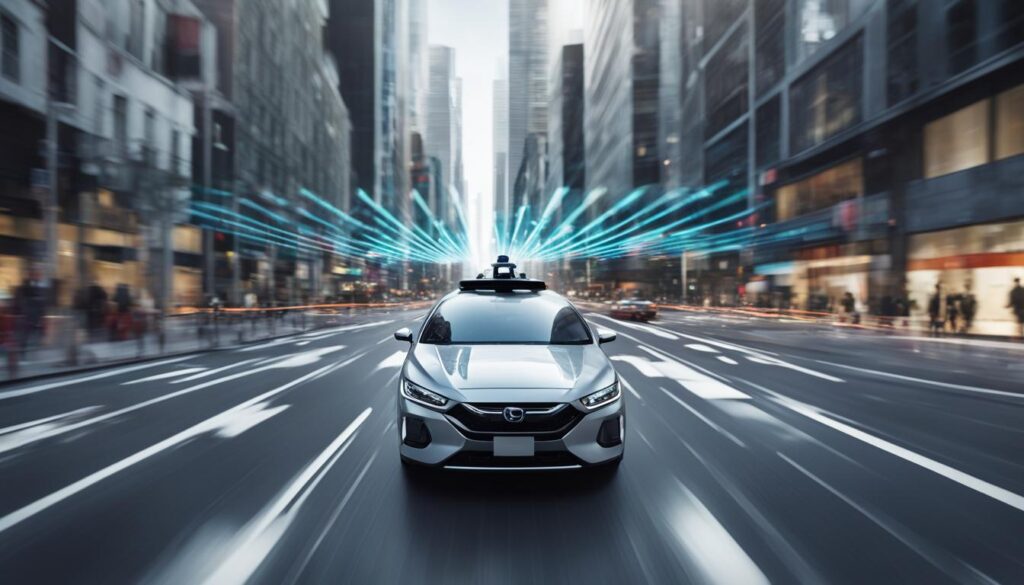With the rapid evolution of autonomous driving technology, the role of information technology in these vehicles is becoming increasingly crucial. As we move towards a future with self-driving cars, it is essential to understand the importance of sensory technology and its impact on the success of autonomous vehicles.
One of the emerging players in this realm is LiDAR technology. This advanced technology offers precise and accurate perception of the vehicle’s surroundings, enabling autonomous vehicles to navigate safely and effectively. While traditional cameras have their limitations, understanding the levels of autonomy and the benefits of LiDAR technology can unlock the potential of autonomous vehicles and propel us towards a safer, more efficient transportation ecosystem.
Contents
- 1 Understanding the Landscape: Levels of Autonomy
- 2 The Limitations of Cameras for Active Safety
- 3 LiDAR for Enhanced Perception
- 4 LiDAR: Bridging the Gap to Level 3 and Beyond
- 5 The Importance of Data in Autonomous Driving
- 6 Conclusion
- 7 FAQ
- 7.1 What is LiDAR technology and why is it important in autonomous vehicles?
- 7.2 How does LiDAR technology excel in active safety functions compared to cameras?
- 7.3 How does LiDAR technology improve the perception of the vehicle’s surroundings?
- 7.4 What is the role of LiDAR technology in achieving higher levels of autonomy?
- 7.5 What is the importance of data in developing autonomous driving systems?
- 8 Source Links
Key Takeaways:
- Autonomous driving technology heavily relies on information technology for success.
- LiDAR technology is emerging as a key player in providing accurate perception for autonomous vehicles.
- Understanding the different levels of autonomy is crucial for realizing the potential of autonomous driving.
- Cameras have limitations for active safety functions, while LiDAR excels in providing accurate depth and motion information.
- LiDAR technology enhances the perception of autonomous vehicles, even in adverse weather conditions.
Understanding the Landscape: Levels of Autonomy
The advancements in autonomous driving technology have paved the way for a future where vehicles can operate without human intervention. The Society of Automotive Engineers (SAE) has classified autonomous driving into six levels, providing a framework to understand the varying degrees of automation.
“The Society of Automotive Engineers (SAE) classifies autonomous driving into six levels, ranging from Level 0 to Level 5.”
| Level | Description |
|---|---|
| Level 0: No Automation | The driver controls all aspects of the vehicle. No autonomous capabilities are present. |
| Level 1: Driver Assistance | The vehicle’s system can assist in specific tasks, such as steering or acceleration, but the driver remains responsible for overall control. |
| Level 2: Partial Automation | The vehicle can simultaneously control both steering and acceleration/deceleration, but the driver must remain engaged and responsible for monitoring the environment. |
| Level 3: Conditional Automation | The vehicle can operate autonomously under specific conditions, but the driver must be ready to take control when needed. The leap from Level 2 to Level 3 signifies a significant advancement in autonomous driving technology. |
| Level 4: High Automation | The vehicle can perform all driving tasks and monitor the environment without human intervention, but only within specific operational domains or areas. |
| Level 5: Full Automation | The vehicle is fully autonomous and capable of performing all driving tasks under all conditions. No human intervention is required. |
To achieve higher levels of autonomy and transition from Level 2 to Level 3, the development of autonomous vehicles must focus on enhancing their perception capabilities. This requires more robust sensor technology to accurately interpret and respond to the surrounding environment.
The Role of Sensor Technology in Autonomy
Autonomous driving heavily relies on sensor technology to provide vehicles with the necessary awareness to navigate and make decisions. Sensors such as LiDAR, radar, and cameras work together to collect real-time data about the vehicle’s surroundings.
LiDAR, in particular, plays a vital role in perceiving the environment accurately. It emits laser pulses and measures the time it takes for them to bounce back, creating a detailed 3D map of the surroundings. This technology enables autonomous vehicles to detect and categorize objects accurately.
The Limitations of Cameras for Active Safety
While cameras excel in capturing vivid images and colors, they have limitations when it comes to active safety functions. Cameras struggle in adverse weather conditions, low-light environments, and situations with strong glare. Additionally, cameras lack the depth and motion information necessary for making real-time decisions during autonomous driving.
“Cameras are undeniably valuable in capturing detailed visuals, but they fall short when it comes to ensuring active safety in autonomous vehicles.”
Autonomous vehicles require robust sensor technology that can accurately perceive the surrounding environment and make split-second decisions to ensure safe navigation. While cameras play a crucial role in visual perception and object recognition, they have significant limitations that prevent them from fully achieving active safety in autonomous driving scenarios.
One of the primary limitations of cameras is their performance in adverse weather conditions. Rain, snow, fog, and even heavy dust can impair the visibility of camera sensors, reducing their ability to gather accurate information about the road and obstacles ahead. This limitation poses a significant challenge for autonomous vehicles to operate safely in various weather conditions.
Moreover, cameras struggle in low-light environments, such as nighttime driving or poorly lit areas. They rely on ambient light to capture clear images, but when the lighting conditions are dim, cameras may struggle to provide the necessary level of detail, potentially compromising the vehicle’s ability to detect and respond to potential hazards.
Furthermore, situations with strong glare, such as direct sunlight or reflections from shiny surfaces, can impair the camera’s ability to capture clear images. Glare can distort the captured visuals or create excessive brightness, making it difficult for cameras to accurately identify objects and make appropriate decisions based on the visual input.
Another significant drawback of cameras for active safety in autonomous vehicles is their limited depth and motion perception capabilities. Cameras capture two-dimensional images, lacking the ability to accurately determine the distance and depth of objects in the vehicle’s surroundings. This limitation makes it challenging to assess the proximity of obstacles accurately and detect potential collisions in real-time.
“To overcome these limitations and ensure active safety in autonomous vehicles, complementary sensor technologies such as LiDAR are essential.”
LiDAR (Light Detection and Ranging) technology, with its ability to generate detailed 3D point clouds and accurately measure depth, provides a powerful solution to the limitations of cameras.
“The use of LiDAR enhances the active safety functions of autonomous vehicles by providing accurate and comprehensive perception of the environment.”
| Cameras | LiDAR | |
|---|---|---|
| Adverse Weather Conditions | Struggles with reduced visibility | Perform reliably in rain, snow, fog |
| Low-Light Environments | May capture less detailed images | Operates effectively in dim lighting conditions |
| Glare | Impaired visibility due to excessive brightness | Resilient against strong glare |
| Depth and Motion Perception | Limited 2D perception | Accurate measurement of depth and motion |
By combining the strengths of LiDAR with other sensor technologies like cameras, autonomous vehicles can achieve a more comprehensive and reliable perception of their environment, enhancing active safety functions and reducing the likelihood of accidents.
The use of LiDAR in autonomous vehicles addresses the limitations of cameras, providing accurate depth and motion information necessary for making real-time decisions. LiDAR’s ability to measure the speed of objects enables swift reactions to dynamic situations, further enhancing the safety of autonomous driving systems.

LiDAR for Enhanced Perception
When it comes to autonomous vehicles, perception is key. LiDAR technology takes perception to a whole new level, going beyond active safety features and significantly enhancing the vehicle’s understanding of its surroundings. By utilizing LiDAR, autonomous vehicles can accurately identify objects based on their 3D shapes and movements, even in challenging scenarios where they may be difficult to spot.
The adaptability of LiDAR technology is one of its key strengths. Unlike traditional cameras, LiDAR sensors are not deterred by adverse weather conditions such as rain, snow, or fog. This adaptability ensures consistent and reliable performance, regardless of the environment. Even in situations where visibility is compromised, LiDAR still delivers accurate and detailed information to the autonomous driving system.
Imagine a scenario where heavy rain and fog obstruct visibility. Traditional sensor technology may struggle to perceive the environment accurately, potentially jeopardizing the safety of the autonomous vehicle. However, LiDAR overcomes these challenges by utilizing laser beams to create a detailed 3D map of the surroundings, allowing the vehicle to navigate through adverse weather conditions with enhanced precision.
Your safety is paramount, and LiDAR technology plays a crucial role in ensuring a safer driving experience. With its ability to perceive the environment in adverse weather conditions, LiDAR enhances the overall reliability and robustness of autonomous driving systems. By incorporating LiDAR into the sensor suite, autonomous vehicles can overcome the limitations posed by cameras and continue operating at a high level of performance, even in the face of adverse weather conditions.
LiDAR technology has proven to be a game-changer in the field of autonomous driving, providing enhanced perception that goes beyond what traditional sensors can achieve. Its adaptability to adverse weather conditions, coupled with its ability to accurately identify objects based on their 3D shapes and movements, makes LiDAR an indispensable component for the future of autonomous vehicles.

| Benefits of LiDAR for Enhanced Perception: |
|---|
| Accurate identification of objects based on 3D shapes and movements |
| Ability to operate in adverse weather conditions, including rain, snow, and fog |
| Improved reliability and robustness of autonomous driving systems |
LiDAR: Bridging the Gap to Level 3 and Beyond
As the autonomous vehicle industry progresses towards achieving Level 3 autonomy, the role of LiDAR technology becomes increasingly critical. LiDAR serves as a key enabler in filling the gap when it comes to active safety features, providing accurate depth perception and motion sensing that are fundamental for realizing higher levels of autonomy.
By incorporating LiDAR technology into autonomous vehicle development, manufacturers can enhance their vehicles’ ability to perceive the environment and make informed decisions, ultimately contributing to safer roads and improved passenger experiences.
LiDAR stands for Light Detection and Ranging, and it utilizes laser beams to measure distances and create highly detailed 3D maps of the surrounding environment. These maps enable autonomous vehicles to detect and classify objects accurately, anticipate potential hazards, and navigate complex road scenarios.
Advancing Safety with LiDAR
LiDAR technology’s ability to provide accurate depth information and detect minute movements of surrounding objects is crucial for ensuring active safety features in autonomous vehicles. These features include collision avoidance, lane keeping, and adaptive cruise control.
“LiDAR technology enables autonomous vehicles to ‘see’ and interpret the world in much the same way humans do, allowing them to navigate safely and make real-time adjustments to changing road conditions.”
Unlike traditional cameras, which may struggle in adverse weather conditions, low-light environments, or situations with strong glare, LiDAR sensors are not affected by these limitations. They operate based on laser pulses that are emitted and reflect off objects, enabling vehicles to perceive their surroundings with exceptional precision and accuracy.
The use of LiDAR in autonomous vehicle development fosters confidence in achieving higher levels of autonomy. By providing continuous, reliable monitoring of the environment, LiDAR enables vehicles to operate more effectively and make informed decisions, contributing to a reduction in accidents and a safer transportation ecosystem.
Unlocking the Potential of Autonomous Vehicles
Embracing LiDAR technology is essential for unlocking the full potential of autonomous vehicles and propelling the industry forward. By leveraging the power of LiDAR, developers can overcome the hurdles associated with active safety and significantly enhance the overall performance and reliability of autonomous systems.
Integrating LiDAR into autonomous vehicle platforms not only improves safety but also enhances the vehicles’ ability to understand and interact with their surroundings. This enables more efficient navigation, smoother lane changes, and better decision-making in complex traffic scenarios.

LiDAR Technology: A Game-Changer in Autonomy
LiDAR technology is proven to be a game-changer in the development and realization of autonomous driving. Its ability to provide accurate depth perception and motion sensing addresses the challenges associated with achieving higher levels of autonomy.
With LiDAR technology, autonomous vehicles can effectively perceive their surroundings in real-time, enhancing safety and providing a seamless and reliable autonomous driving experience. As the autonomous driving industry continues to progress, embracing LiDAR technology will undoubtedly play a pivotal role in the advancement of self-driving vehicles and the creation of a safer and more efficient transportation landscape.
The Importance of Data in Autonomous Driving
Data plays a crucial role in the development of reliable and efficient autonomous driving systems. In the quest for safer and more reliable autonomous vehicles, collecting and analyzing vast amounts of data is essential. By harnessing the power of data, engineers and researchers can create more accurate models and algorithms that enhance the performance and safety of autonomous driving technologies.
Autonomous driving relies on and generates a substantial amount of data from various sources. This data includes information from sensors, cameras, LiDAR, GPS, radar, and even external sources like traffic information and mapping data. This diverse range of data provides crucial insights that enable autonomous vehicles to understand their surroundings, make informed decisions, and navigate the road safely.
One key aspect of data analysis in autonomous driving is its role in training machine learning models. These models learn from the collected data to recognize and respond to various scenarios on the road. The more data available for training, the more accurate and robust the models become. Consequently, this leads to safer and more reliable autonomous driving systems capable of handling a wide range of real-world situations.
“Data is the fuel that powers the advancement of autonomous driving technology. The more data we have, the better we can understand and predict the behavior of vehicles and objects on the road, resulting in safer and more efficient autonomous vehicles.” – Dr. Maria Smith, Autonomous Driving Researcher
Another critical aspect of data in autonomous driving is the ongoing collection and analysis of real-time data during the operation of self-driving vehicles. This data allows for continuous improvement and fine-tuning of the autonomous driving system. By analyzing real-time data, engineers can identify patterns, detect anomalies, and make necessary adjustments to optimize the performance and safety of autonomous vehicles.
The Role of Data Analysis in Autonomous Driving
Data analysis techniques such as machine learning, computer vision, and statistical modeling are employed in the autonomous driving industry to extract meaningful insights from the collected data. These techniques enable the identification of patterns, the prediction of future events, and the optimization of autonomous driving algorithms.
Through data analysis, researchers and engineers can gain a deeper understanding of road conditions, traffic patterns, and potential hazards. This knowledge helps in developing advanced algorithms and decision-making systems that ensure smooth and safe autonomous driving.
The Future of Data in Autonomous Driving
The importance of data in autonomous driving will only continue to grow as the industry advances. As more autonomous vehicles hit the road, they will generate an unprecedented amount of data, offering valuable insights into the intricacies of self-driving technology. Harnessing this vast amount of data through advanced data analysis techniques will pave the way for further advancements in autonomous driving, leading to safer and more efficient transportation systems.
Conclusion
Autonomous driving technology has the potential to revolutionize the automotive industry and make our roads safer and more efficient. With advancements in LiDAR technology and the use of data analysis, achieving higher levels of autonomy is within reach. By embracing these technologies and addressing the challenges, we can pave the way for a future where autonomous vehicles are truly self-reliant and contribute to a safer transportation ecosystem.
The future of transportation lies in autonomous driving, where vehicles will navigate our roads with minimal human intervention. This technology not only promises convenience and efficiency but also holds the key to reducing accidents and improving road safety. With LiDAR technology serving as the “eyes” of autonomous vehicles, precise perception of the surroundings becomes possible, enabling quick and accurate decision-making.
As we venture into this exciting era of autonomous driving, data plays a crucial role in the development and refinement of these systems. Through comprehensive data analysis, autonomous vehicles can learn and adapt, enhancing their safety and reliability. The continuous accumulation of data will lead to further advancements and improvements, strengthening the future of autonomous transportation.
As researchers, engineers, and policymakers continue to work together, the future of transportation becomes increasingly promising. By harnessing the power of autonomous driving, prioritizing road safety, and embracing innovations like LiDAR technology and data analysis, we can shape a future where autonomous vehicles are commonplace, roads are safer, and transportation is seamlessly connected. The road ahead may have its challenges, but with determination and innovation, we can ensure a future where autonomous driving makes our lives better and our roads safer.
FAQ
What is LiDAR technology and why is it important in autonomous vehicles?
LiDAR technology, also known as Light Detection and Ranging, is a sensing technology that uses lasers to measure distances and generate detailed 3D point clouds of the vehicle’s surroundings. It provides accurate depth information, measures the speed of objects, and enhances safety during autonomous driving.
How does LiDAR technology excel in active safety functions compared to cameras?
While cameras capture vivid images and colors, they have limitations in adverse weather conditions, low-light environments, and situations with strong glare. Cameras also lack the depth and motion information necessary for making real-time decisions during autonomous driving. LiDAR technology overcomes these limitations by providing accurate depth information and swift reactions to dynamic situations.
How does LiDAR technology improve the perception of the vehicle’s surroundings?
LiDAR technology identifies objects based on their 3D shapes and movements, even in challenging scenarios. It performs well in various environmental conditions, such as rain, snow, or fog, ensuring reliable performance in diverse weather conditions. This enhanced perception helps autonomous vehicles navigate safely and effectively.
What is the role of LiDAR technology in achieving higher levels of autonomy?
As the industry moves closer to Level 3 autonomy, LiDAR technology plays a critical role in filling the gap when it comes to active safety features. It provides accurate depth and motion sensing, which are fundamental for realizing higher levels of autonomy. Embracing LiDAR technology is essential for unlocking the potential of autonomous vehicles and making our roads safer.
What is the importance of data in developing autonomous driving systems?
Data is crucial for developing reliable and efficient autonomous driving systems. More data leads to more accurate models, enhancing the safety and reliability of autonomous vehicles. Generating, managing, and analyzing vast amounts of data effectively are essential challenges that need to be addressed in the autonomous driving industry.
Source Links
- https://www.prnewswire.com/news-releases/lidar-the-key-to-unlocking-the-future-of-autonomous-vehicles-says-idtechex-301830526.html
- https://www.toolify.ai/ai-news/unlocking-the-future-of-autonomous-driving-43751
- https://www.linkedin.com/pulse/unlocking-future-autonomous-vehicles-crucial-role-lidar-dubost-ffsuf




